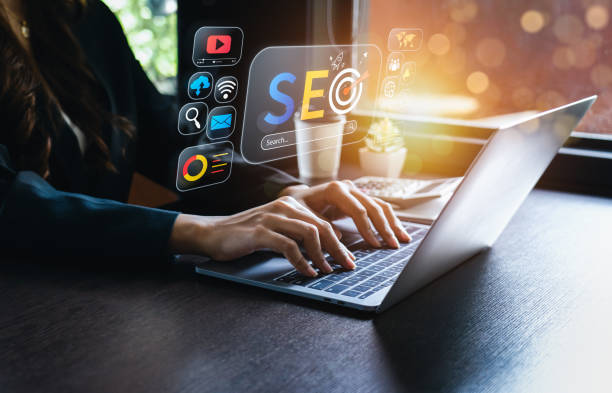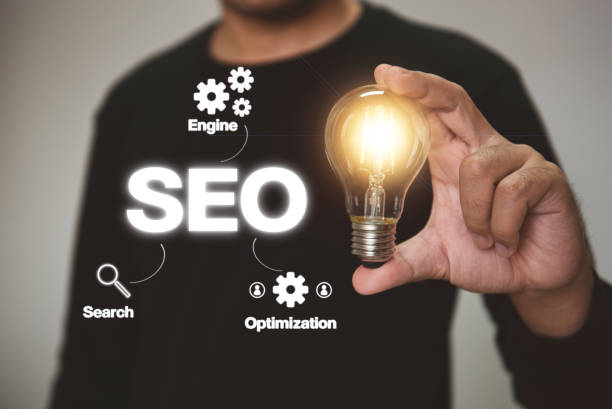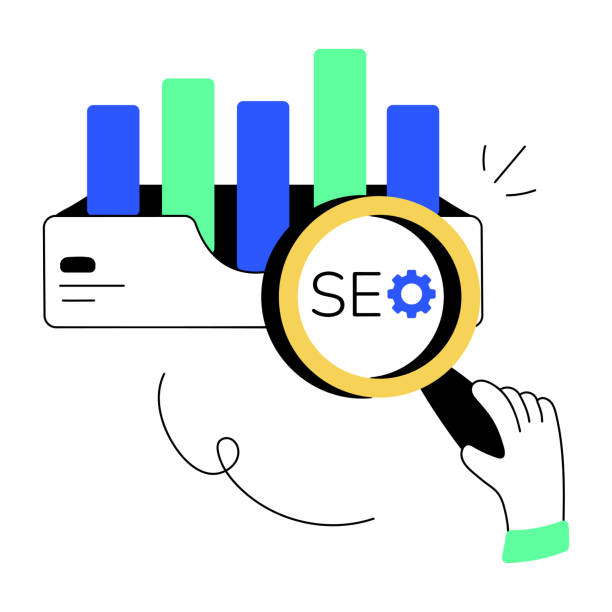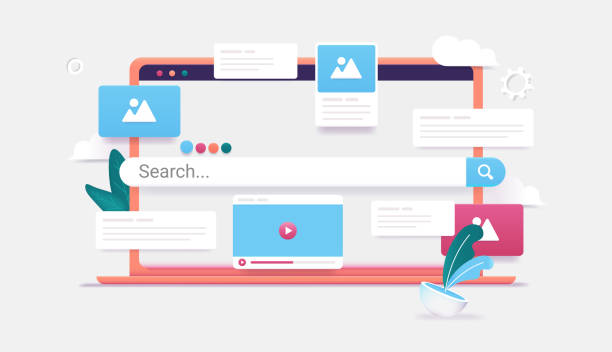What is On-Page SEO and Why is it Important?
On-Page SEO is the set of actions taken to optimize website pages to improve their ranking in search engines.
These actions include content optimization, the use of appropriate keywords, improving site structure, and internal linking.
The importance of On-Page SEO lies in the fact that search engines like Google use these factors to determine the relevance and quality of web pages.
A website with strong On-Page SEO has a better chance of achieving a high ranking in search results and attracting organic traffic.
This is particularly crucial for businesses looking to increase online visibility and attract more customers.
#Content optimization and proper use of keywords are among the most important aspects of On-Page SEO.
In addition, On-Page SEO also helps with User Experience.
A website with a proper structure, easy navigation, and engaging content keeps users on the site longer and reduces the Bounce Rate.
These factors, in turn, have an impact on the site’s ranking.
In short, On-Page SEO is a bridge between your website and search engines, and by optimizing it correctly, you can achieve significant results.
Therefore, investing in On-Page SEO is a smart strategy for the growth and development of your online business.
Does your current corporate website present a worthy image of your brand and attract new customers?
If not, turn this challenge into an opportunity with Rasaweb’s professional corporate website design services.
✅ Significantly improves your brand’s credibility and image.
✅ Paves the way for attracting leads and new customers for you.
⚡ Contact Rasaweb now for a free and specialized consultation!
Keyword Research – Finding the Best Phrases to Target
Keyword Research is one of the most important steps in the On-Page SEO process.
The purpose of this step is to find the words and phrases that users use to search for your products and services in search engines.
By identifying these keywords, you can optimize your website content based on them and increase your chances of being seen in search results.
There are various tools available for keyword research, including Ahrefs, SEMrush and Google Keyword Planner.
These tools help you find search volume, competition levels, and related keywords.
When choosing keywords, keep two important points in mind: first, the relevance of the keyword to the page content.
Second, the level of competition for that keyword.
It is best to choose words that are relevant to the page content and for which competition is relatively low.
This will help you achieve high rankings in search results in a shorter amount of time.
Also, pay attention to the diversity of keywords and use Long-Tail Keywords as well.
These keywords usually have less search volume, but their Conversion Rate is higher.
Therefore, by targeting these keywords, you can attract more targeted traffic to your website.
On-Page SEO without proper keyword research is like a building without a foundation.
Optimizing Page Title (Title Tag) and Meta Description
The Title Tag and Meta Description are two important elements in On-Page SEO that are displayed in search results.
The title tag is the main title of the web page, which is also displayed in the browser tab.
The meta description is a short summary of the page content that is displayed below the page title in search results.
Optimizing these two elements is very important for improving the Click-Through Rate and increasing organic traffic.
To optimize the title tag, use the page’s main keyword at the beginning of the title.
The title should be attractive, concise, and relevant to the page content.
The length of the title tag should not exceed 60 characters.
To optimize the meta description, write an engaging and descriptive summary of the page content.
Also use the page’s main keyword in the meta description.
The length of the meta description should not exceed 160 characters.
The goal of writing a meta description is to encourage users to click on your website link in search results.
Therefore, the meta description should be written in such a way that it arouses users’ curiosity and convinces them that your website is the best source for answering their questions.
By correctly optimizing the title tag and meta description, you can significantly increase traffic to your site.
Strong On-Page SEO requires attention to these details.
| Element | Best Practice |
|---|---|
| Title Tag | Use the main keyword, be attractive and concise, maximum 60 characters |
| Meta Description | Attractive and descriptive summary, use the main keyword, maximum 160 characters |
Click here to preview your posts with PRO themes ››
| Note | Description |
|---|---|
| Relevance | The title and description should be relevant to the page content |
| Attractiveness | The title and description should be attractive to users and encourage them to click |
Content Optimization – Producing High-Quality and Engaging Content
Producing high-quality and engaging content is one of the most important factors in On-Page SEO.
Search engines are looking for content that is useful and valuable to users.
Therefore, you should create content that answers users’ questions, solves their problems, and provides them with useful information.
To produce high-quality content, first identify the topics that interest and meet the needs of users.
Then, using keyword research, find keywords related to these topics.
Finally, create content that revolves around these keywords and answers users’ questions.
Your content should be unique, comprehensive, and accurate.
Avoid copying content from others and try to create content that has added value for users.
Use images, videos, and other multimedia elements to make your content more engaging.
Update your content regularly and add new information to it.
By producing high-quality and engaging content, you can attract users to your website and turn them into your customers.
Effective On-Page SEO is not possible without valuable content.
Content creation also helps with Content Marketing as well.
Tired of losing customers due to poor online store design? With Rasaweb, solve this problem forever!
✅ Increase sales and visitor-to-customer conversion rate
✅ Smooth and attractive user experience for your customers⚡ Get a free consultation
URL Structure – Creating SEO-Friendly URLs
URL structure is an important factor in On-Page SEO that is often overlooked.
URLs should be short, descriptive, and contain the page’s main keyword.
Avoid using uppercase letters, spaces, and special characters in URLs.
Use a hyphen (-) instead of a space.
URLs should be such that users and search engines can easily understand the content of the page.
For example, instead of using complex and incomprehensible URLs like `example.com/page?id=123`, use simple and descriptive URLs like `example.com/seo-internal`.
The URL structure should be logical and hierarchical.
Related pages should be in subsets of each other.
This helps search engines better understand your site structure and index your pages correctly.
Avoid creating duplicate URLs.
Each page should have a unique URL.
If there are duplicate URLs, use the Canonical tag to tell search engines which URL is the original version of the page.
By optimizing the URL structure, you can help improve your website’s ranking in search results.
Smart On-Page SEO pays attention to all the details.
Image Optimization – Using Appropriate Alt Tags and File Names
Image optimization is another important aspect of On-Page SEO that helps improve website ranking in search results.
Images can drive a lot of traffic to your website, provided they are properly optimized.
To optimize images, first use high-quality images that are relevant to the page content.
Reduce the size of images to increase page loading speed.
Use appropriate formats such as JPEG, PNG, and WebP.
Write an appropriate Alt tag (alternative text) for each image.
The Alt tag should be descriptive, relevant to the image content, and contain the page’s main keyword.
The Alt tag helps search engines understand the content of the image and display it in search results.
Also optimize the image file names.
Use descriptive and content-related names for the image.
Instead of default names like `IMG_1234.jpg`, use names like `seo-internal.jpg`.
By optimizing images, you can help improve user experience, increase page loading speed, and improve your website’s ranking in search results.
Comprehensive On-Page SEO covers all elements of the page.
Click here to preview your posts with PRO themes ››
Internal Linking – Creating a Network of Links Within the Site
Internal Linking refers to the process of creating links between different pages of a website.
Internal linking helps search engines better understand your site structure and index your pages correctly.
Also, internal linking helps users easily navigate your site and find the content they are looking for.
For internal linking, use Text Links.
Text links should be relevant to the content of the page they link to.
Use relevant keywords in the link text.
Give more links to the more important pages of the site.
The more important pages of the site are those that receive the most traffic or are more important for your business.
Avoid linking to Broken Links.
Broken pages are pages that no longer exist or do not work correctly.
Linking to broken pages reduces the user experience and damages your website’s ranking.
Smart On-Page SEO uses internal linking to improve site structure and user experience.
| Link Type | Description |
|---|---|
| Text Links | Using relevant keywords in the link text |
| Link to Important Pages | Linking more to pages that have high traffic |
| Item | Recommendation |
|---|---|
| Broken Links | Preventing linking to broken pages |
| Relevance | Links should be relevant to the page content |
Page Loading Speed – Optimization for Better User Experience
Page Speed is an important factor in On-Page SEO and user experience.
Users who experience slow page loading speeds are likely to leave your site and go to your competitors.
Search engines also pay attention to page loading speed, and sites with faster loading speeds rank better in search results.
To improve page loading speed, first check your page loading speed using tools such as Google PageSpeed Insights.
These tools help you identify problems with page loading speed.
Then, optimize images, use a CDN (content delivery network), compress code, use cache, and use quality hosting.
By improving page loading speed, you can improve the user experience, reduce the bounce rate, and increase your website’s ranking in search results.
Advanced On-Page SEO considers site speed as a key factor.
Does your current corporate website present a worthy image of your brand and attract new customers?
If not, turn this challenge into an opportunity with Rasaweb’s professional corporate website design services.
✅ Significantly improves your brand’s credibility and image.
✅ Paves the way for attracting leads and new customers for you.
⚡ Contact Rasaweb now for a free and specialized consultation!
Responsive Design – Optimization for Different Devices
Responsive Design means designing a website that automatically adapts to the screen size of different devices (such as computers, tablets, and mobile phones).
Today, a large number of users access the Internet through mobile devices.
Therefore, having a responsive website is very important for On-Page SEO and user experience.
Search engines also pay attention to responsive design, and sites that are responsive rank better in search results.
To have a responsive website, use CSS frameworks such as Bootstrap.
Use high-quality and optimized images and videos.
Make site navigation simple and easy for mobile devices.
By having a responsive website, you can improve the user experience, reduce the bounce rate, and increase your website’s ranking in search results.
Modern On-Page SEO is not possible without paying attention to site responsiveness.
Schema Markup – Helping Search Engines Better Understand Content
Schema Markup is a type of code that helps search engines better understand the content of your website pages.
By using Schema Markup, you can provide accurate information to search engines about products, services, events, articles, and other types of content.
This helps search engines better index your content and show it to users in search results.
To use Schema Markup, follow the Schema.org standards.
Add Schema Markup to the HTML code of your pages.
Use Schema Markup testing tools to check the validity of your code.
Click here to preview your posts with PRO themes ››
By using Schema Markup, you can increase the chances of displaying Rich Snippets in search results.
Rich snippets are additional information that is displayed below the page title in search results.
This information can include ratings, prices, images, and other information related to the page content.
Displaying rich snippets in search results increases the click-through rate and attracts more traffic to your website.
Using Schema Markup is an advanced technique in On-Page SEO that can help improve your website’s ranking and traffic.
Frequently Asked Questions
| Question | Answer |
|---|---|
| What is On-Page SEO? | It refers to the set of actions taken within a website to improve ranking in search engines. |
| Why is On-Page SEO important? | Because it helps search engines better understand the content and structure of your site and improves the user experience. |
| What are the most important elements of On-Page SEO? | Title and meta descriptions, keywords, URL structure, high-quality content, image optimization, internal linking, and site speed. |
| How do we optimize the Title Tag and Meta Description? | The title should include the main keyword and be attractive, and the meta description should be a persuasive summary of the content with relevant keywords. |
| What is the role of keywords in On-Page SEO? | Keywords help search engines understand what the page content is about and should be used naturally and intelligently in the text. |
| How is image optimization done for On-Page SEO? | By compressing the size, using a descriptive file name, and filling the Alt tag with relevant descriptions and keywords. |
| What is internal linking and what is its application? | It is the connection of different pages of the site to each other. This helps to distribute the authority of the pages (Page Authority) and improve the crawlability of search engines. |
| What is the importance of site loading speed in On-Page SEO? | High speed improves user experience and is one of the important ranking factors for search engines like Google. |
| How does the responsive nature (Mobile-Friendliness) of the site affect On-Page SEO? | Considering the increase in mobile users, responsiveness is necessary to provide a suitable user experience on all devices and Google’s mobile-first indexing priority. |
| What are the important factors related to content in On-Page SEO? | Originality, quality, comprehensiveness, readability, proper use of headings (H1, H2,…) and regular content updates. |
And other services of Rasa Web advertising agency in the field of advertising
Smart advertising campaign: a combination of creativity and technology to manage campaigns by optimizing key pages.
Smart Google Ads: a combination of creativity and technology to increase click-through rate through dedicated programming.
Smart sales automation: a fast and efficient solution to increase click-through rates by focusing on attractive user interface design.
Smart Google Ads: Designed for businesses looking to increase click-through rates by optimizing key pages.
Smart Google Ads: Professional optimization to improve SEO ranking using Google Ads management.
And more than a hundred other services in the field of internet advertising, advertising consulting and organizational solutions
Internet advertising | Advertising strategy | Advertorial report
Sources
On-Page SEO Checklist
,On-Page SEO Optimization from Moz
,Complete On-Page SEO Guide from Semrush
,On-Page SEO Tutorial from Ahrefs
? Are you ready to transform your business in the digital world? Rasaweb Digital Marketing Agency paves the way for your success with expertise in custom website design, SEO, and digital marketing strategies. Contact us today and build your digital future.
📍 Tehran, Mirdamad Street, next to Central Bank, South Kazerun Alley, Ramin Alley No. 6















